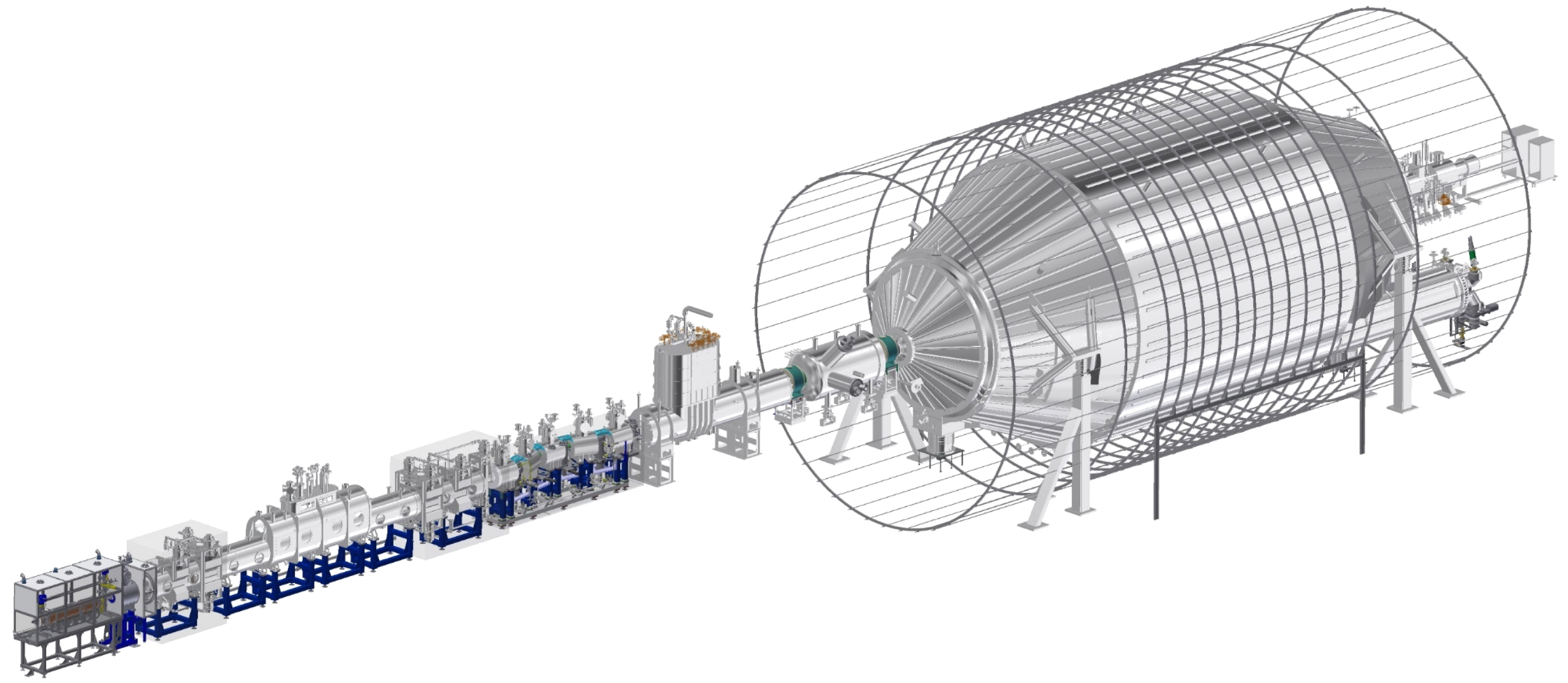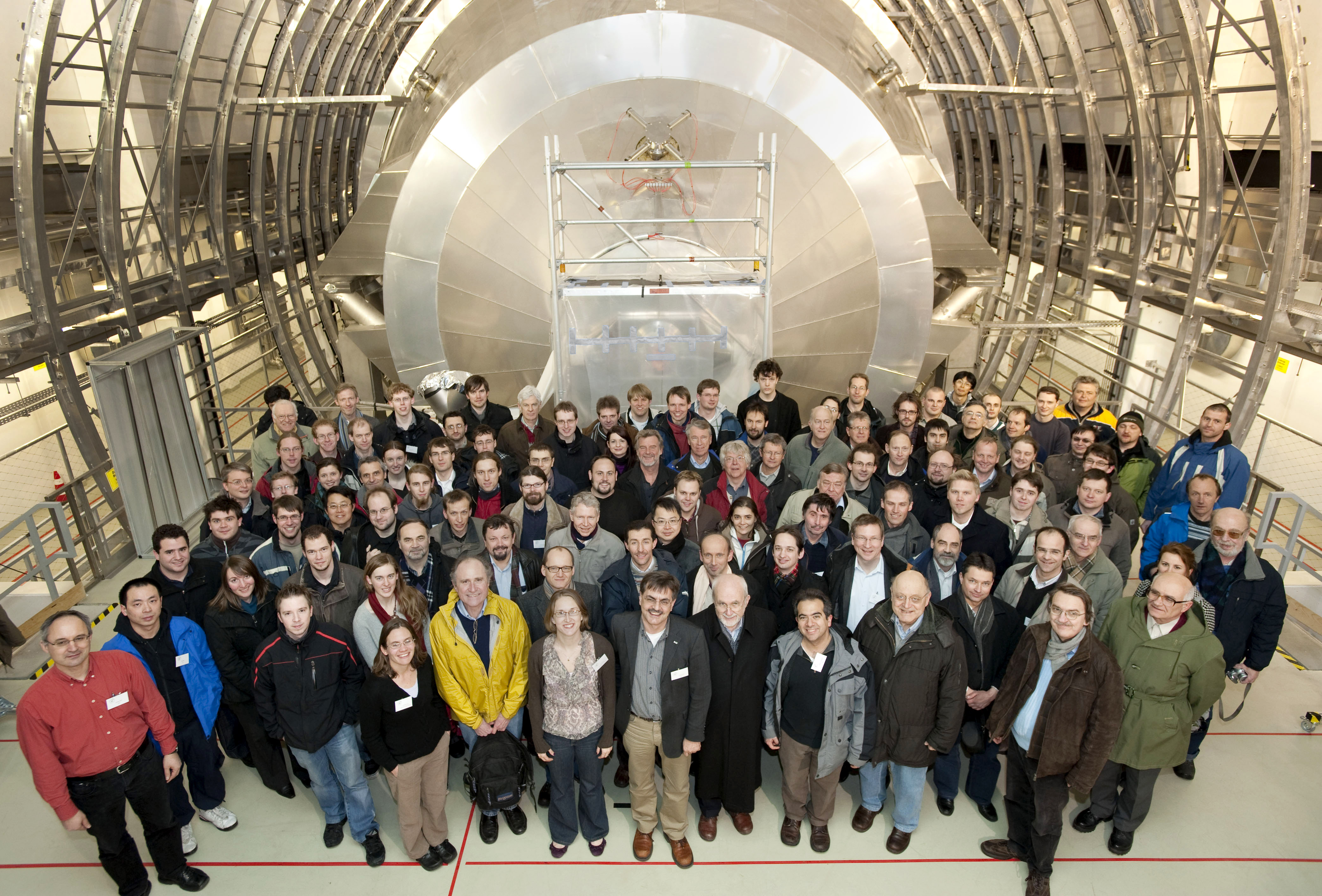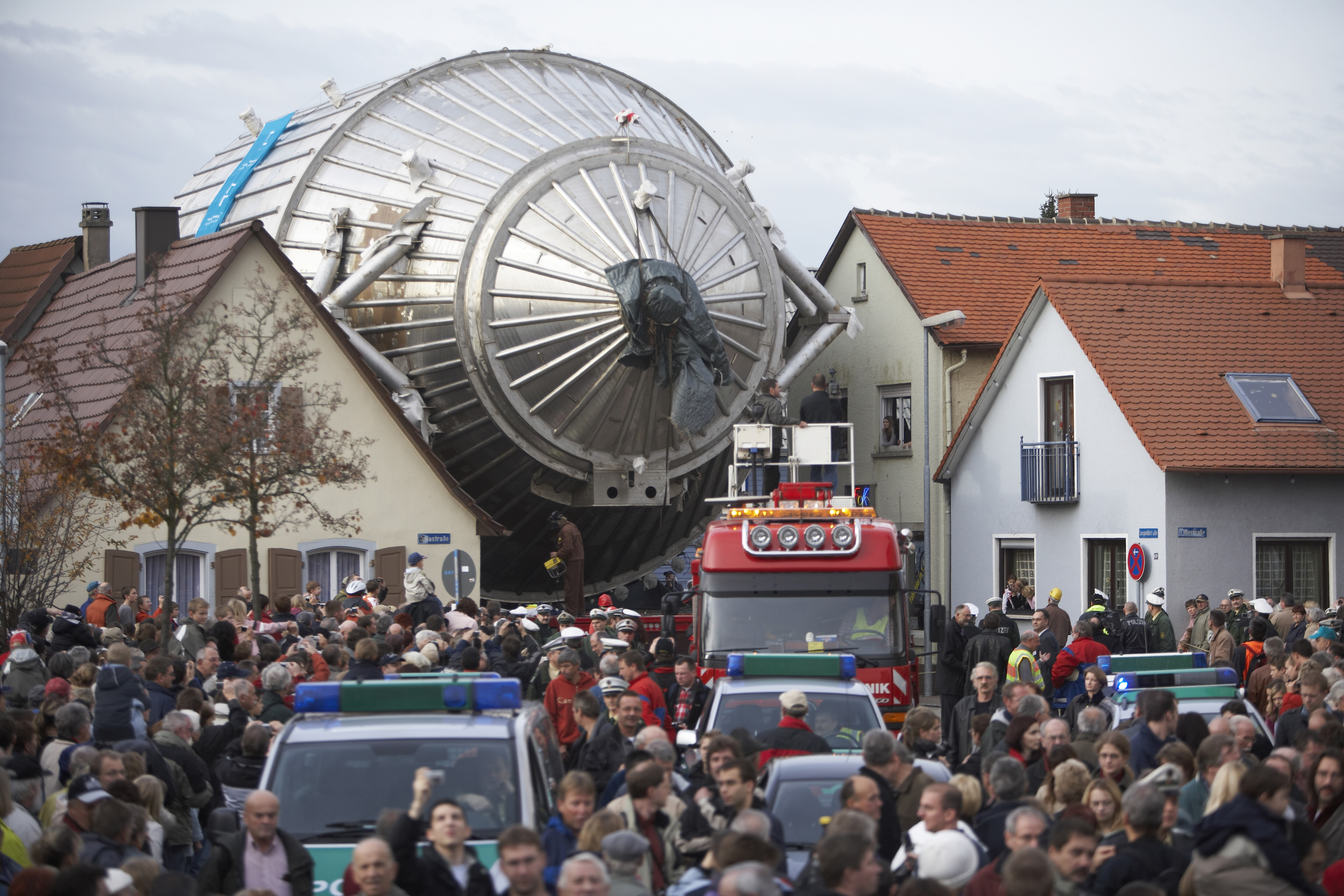
A diagram of the layout and major features of the KATRIN experimental facility at the Karlsruhe Institute of Technology. (Credit: Karlsruhe Institute of Technology)
Note: This press release was adapted from an original release published by the University of Washington.
An international team of scientists that includes researchers at the Department of Energy’s Lawrence Berkeley National Laboratory (Berkeley Lab) has announced a breakthrough in its quest to measure the mass of the neutrino, one of the most abundant yet elusive elementary particles in our universe.
At the 2019 Topics in Astroparticle and Underground Physics conference in Toyama, Japan, leaders from the KATRIN experiment reported Sept. 13 that the rest mass of the neutrino is not larger than 1 electron volt, or eV. These inaugural results, obtained earlier this year by the Karlsruhe Tritium Neutrino (KATRIN) experiment, cut the mass range for the neutrino by more than half by lowering the upper limit of the neutrino’s mass from 2 eV to 1 eV.

(Click image for larger view.) Members of the KATRIN experiment pose in front of the spectrometer after it was installed at the Karlsruhe Institute of Technology. (Credit: Joachim Wolf/Karlsruhe Institute of Technology)
“These findings by the KATRIN collaboration reduce the previous mass range for the neutrino by a factor of two, place more stringent criteria on what the neutrino’s mass actually is, and provide a path forward to measure its value definitively,” said Hamish Robertson, a KATRIN scientist and professor emeritus of physics at the University of Washington.
“Knowing the mass of the neutrino will allow scientists to answer fundamental questions in cosmology, astrophysics, and particle physics, such as how the universe evolved or what physics exist beyond the Standard Model” of particle physics, Robertson added.
The KATRIN experiment is based at the Karlsruhe Institute of Technology in Germany and involves researchers at 20 research institutions around the globe. Berkeley Lab’s KATRIN team is led by Alan Poon, deputy director of Berkeley Lab’s Nuclear Science Division.
Poon noted that Berkeley Lab’s Low Background Facility, which measures very-low levels of natural radioactivity in materials, was used to certify the high-purity materials used in KATRIN’s components and ensure minimal interference with the experiment. Berkeley Lab’s supercomputing resources also aided in KATRIN simulations and data analyses.
“Our Berkeley Lab team applied our expertise in materials testing and data analysis to help validate this important measurement,” Poon said.
Other U.S. KATRIN member institutions are the University of North Carolina at Chapel Hill, the Massachusetts Institute of Technology (MIT), Carnegie Mellon University, and Case Western Reserve University.
These U.S. institutions have made broad contributions to KATRIN, including providing the electron-detector system — the “eye” of KATRIN — which looks into the heart of the spectrometer, an instrument built at the University of Washington.
Among the contributions:
- The University of North Carolina at Chapel Hill led the development of the detector’s data acquisition system, the “brains” of KATRIN.
- MIT’s contribution was the design and development of the simulation software used to model the response of KATRIN.
- Berkeley Lab contributed to the creation of the physics analysis program and provided access to national computing facilities, and quick analysis was enabled by a suite of applications that originated at the University of Washington.
- The Case Western Reserve University was responsible for the design of the electron gun, central to calibrating the KATRIN apparatus.
- Carnegie Mellon University contributed primarily to analysis, and assisted in coordinating analysis for the experiment.
Neutrinos are abundant. They are one of the most common fundamental particles in our universe, second only to photons. Yet neutrinos are elusive. They are neutral particles with no charge. They interact with matter only through the aptly named “weak interaction,” which means that opportunities to detect them and measure their mass are both rare and difficult.
“If you filled the solar system with lead out to 50 times beyond the orbit of Pluto, about half of the neutrinos emitted by the sun would still leave the solar system without interacting with that lead,” Robertson said.
Neutrinos are also mysterious particles that have shaken up our understanding of physics, cosmology, and astrophysics. The Standard Model of particle physics had once predicted that neutrinos should have no mass. But in 1998, scientists published evidence from the Super-Kamiokande detector in Japan that they actually do have a nonzero mass – a breakthrough recognized in 2015 with the Nobel Prize in Physics. Since that discovery scientists have been trying to measure its precise value.
“Solving the mass of the neutrino would lead us into a brave new world of creating a new Standard Model,” said Peter Doe, a research professor of physics at the University of Washington who participates in the KATRIN experiment.
The KATRIN discovery stems from direct, high-precision measurements of how a rare type of electron-neutrino pair share energy. This approach is the same as neutrino-mass experiments from the early 2000s in Mainz, Germany, and Troitsk, Russia, both of which set the previous upper limit of the mass at 2 eV.
The heart of the KATRIN experiment is the source that generates electron-neutrino pairs: gaseous tritium, a highly radioactive isotope of hydrogen. As the tritium nucleus undergoes radioactive decay, it emits a pair of particles: one electron and one neutrino, both sharing 18,560 eV of energy.
KATRIN scientists cannot directly measure the neutrinos, but they can measure the electrons, and try to calculate neutrino properties based on electron properties.
Most of the electron-neutrino pairs emitted by the tritium share their energy load equally. But in rare cases the electron takes nearly all the energy, leaving only a tiny amount for the neutrino.
Those rare pairs are what KATRIN scientists are after because – thanks to Einstein’s famous “energy equals mass times the speed of light squared” (E=mc2) equation – scientists know that the miniscule amount of energy left for the neutrino corresponds to its rest mass. If KATRIN can accurately measure the electron’s energy, they can calculate the neutrino’s energy and therefore its mass.
The tritium source generates about 25 billion electron-neutrino pairs each second, only a fraction of which are pairs in which the electron takes nearly all the decay energy. The KATRIN facility in Karlsruhe uses a complex series of magnets to channel these electrons away from the tritium source and toward the experiment’s 200-ton electrostatic spectrometer, which measures the energy of the electrons with high precision.
An electric potential within the spectrometer creates an “energy gradient” that electrons must “climb” in order to pass through the spectrometer for detection. Adjusting the electric potential allows scientists to study these rare high-energy electrons, which carry information about the neutrino mass.

The spectrometer for the KATRIN experiment, as it works its way through the German town of Eggenstein-Leopoldshafen in 2006 on its way to the nearby Karlsruhe Institute of Technology. (Credit: Karlsruhe Institute of Technology)
Björn Lehnert, a postdoctoral researcher at the Berkeley Lab, used the Cori supercomputer at Berkeley Lab’s National Energy Research Scientific Computing Center (NERSC) to perform a comparative tritium measurement for the study using a separate analysis technique.
Lehnert’s analysis is based on a software platform that was developed by the KATRIN team at the Technical University of Munich. The Munich team is headed by Susanne Mertens, a former Berkeley Lab postdoctoral researcher who led a study on how to use KATRIN to search for hypothetical particles called sterile neutrinos. Sterile neutrinos are a possible candidate for the dark matter that, though accounting for 85% of the matter in the universe, remains undetected.
KATRIN researchers also used NERSC to support several studies of the electromagnetic field that is used to guide beta electrons from tritium decays inside spectrometer.
With tritium data acquisition now underway, U.S. institutions are focused on analyzing these data to further improve our understanding of neutrino mass.
“KATRIN is not only a shining beacon of fundamental research and an outstandingly reliable high-tech instrument, but also a motor of international cooperation that provides first-class training of young researchers,” KATRIN co-spokespersons Guido Drexlin of the Karlsruhe Institute of Technology and Christian Weinheimer of the University of Münster said in a statement.
Now that KATRIN scientists have set a new upper limit for the mass of the neutrino, project scientists are working to narrow the range even further.
“Neutrinos are strange little particles,” Doe said. “They’re so ubiquitous, and there’s so much we can learn once we determine this value.”
NERSC is a U.S. Department of Energy Office of Science User Facility. KATRIN is supported by the DOE Office of Nuclear Physics.
More:
###
Founded in 1931 on the belief that the biggest scientific challenges are best addressed by teams, Lawrence Berkeley National Laboratory and its scientists have been recognized with 13 Nobel Prizes. Today, Berkeley Lab researchers develop sustainable energy and environmental solutions, create useful new materials, advance the frontiers of computing, and probe the mysteries of life, matter, and the universe. Scientists from around the world rely on the Lab’s facilities for their own discovery science. Berkeley Lab is a multiprogram national laboratory, managed by the University of California for the U.S. Department of Energy’s Office of Science.
DOE’s Office of Science is the single largest supporter of basic research in the physical sciences in the United States, and is working to address some of the most pressing challenges of our time. For more information, please visit energy.gov/science.